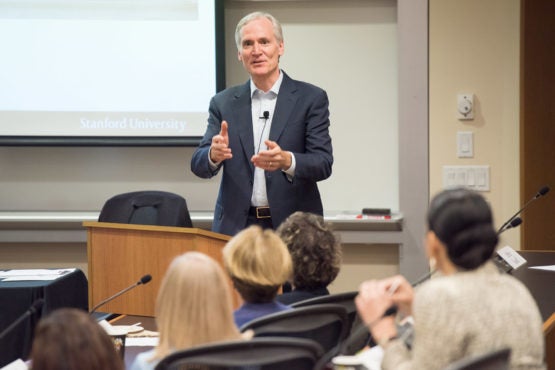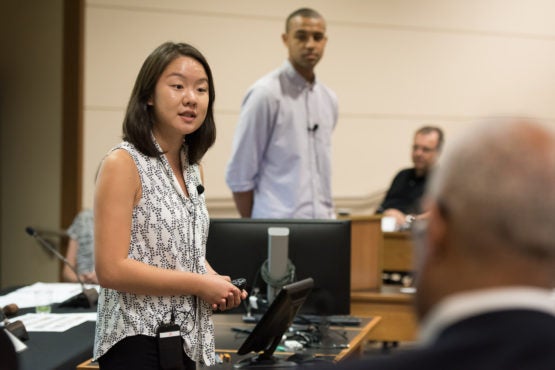At Faculty Senate, President Marc Tessier-Lavigne looks ahead to Stanford’s future; student leaders discuss diversity
At the Faculty Senate meeting Thursday, President Marc Tessier-Lavigne looked back on his first year and ahead to Stanford’s coming years, while ASSU leaders Justice Tention-Palmer and Vicki Niu presented a report on academics and diversity.

President Marc Tessier-Lavigne speaking to the Faculty Senate. (Image credit: L.A. Cicero)
President Marc Tessier-Lavigne addressed the first Faculty Senate meeting of the academic year with a forward-looking update on the long-range planning process and a report on his first year in office.
Also at the meeting, the executive leaders of the Associated Students of Stanford University (ASSU) gave a report on diversity and academics at Stanford that examined the issue through the lenses of teaching, curriculum and mentorship.
The Faculty Senate is launching its 50th year, which will be celebrated throughout the year with symposia, publications and library exhibits.
Looking back, and ahead
Tessier-Lavigne expressed enthusiasm and optimism about Stanford and its future. Recognizing the university’s faculty, students, staff, alumni, friends and trustees, he observed that the Stanford community is driven to excellence – not for its own sake, but to benefit humanity.
Emphasizing the importance of Stanford leading with humility, confident but not arrogant, Tessier-Lavigne also cautioned against complacency and thinking too small when developing the vision for Stanford’s future.
Given the talents of the community and the academic strengths of the university across the breadth of its schools and disciplines, he urged members of the Stanford community to “think big and be bold.”
“We have the capacity, the opportunity and the responsibility to change the world,” he said. “Our biggest danger is to be too incremental, not ambitious enough.”
Tessier-Lavigne said that Stanford’s unique asset is its strength across the breadth of disciplines. Dispelling the outmoded notion that technology could solve every problem, he said, “We now acknowledge that it’s bringing technology together with the humanistic values and outlook that will enable us to tackle the world’s great problems.”
The long-range planning process is moving forward with strong participation, Tessier-Lavigne said. Four area steering groups are finishing up their evaluations of the more than 2,800 ideas and proposals that have come forward for helping shape the university’s future. The steering groups will update the Faculty Senate in November, while the Executive Cabinet will begin reviewing the groups’ work to analyze and synthesize the proposals.
Earlier in his presentation, Tessier-Lavigne celebrated some of the highlights of the 2016-17 academic year, his first as president. They included continued research strength amid relatively stable research funding, 136 new faculty appointments and 180 faculty awards and honors, and innovations in teaching in multiple schools. Enhancing faculty diversity and affordability for members of the campus community will continue to be among the university’s most urgent priorities, he said.

ASSU Vice President Vicki Niu and President Justice Tention-Palmer at the Faculty Senate. (Image credit: L.A. Cicero)
The president’s presentation also touched on enhancements to the student experience, including increased support services, facilities renovations and increased opportunities for students to participate in service.
He also discussed challenges that have been confronting both Stanford and higher education in general, including immigration policy changes, supporting student well-being and preventing sexual violence, free speech, and the cultural and political divisions in the country as a whole. He said he and Provost Persis Drell will continue their efforts to increase communication and engagement with the campus community.
Student leaders report
Following a brief overview of the mission and structure of the organization, ASSU President Justice Tention-Palmer and Vice President Vicki Niu gave a report on academics and diversity at Stanford, touching on teaching, curricular initiatives and mentorship.
Niu said many minority, first-generation, low-income and disabled students may have difficulty adjusting to college life and she urged the Stanford community to practice “active inclusivity.” One of the ways the ASSU is working to tackle this issue is by developing accessibility and cultural sensitivity trainings for faculty and teaching assistants.
Data collected through the 2015 campus climate survey indicates that underrepresented students at Stanford feel less connected to faculty and more overwhelmed by their academic load, Niu reported. Faculty Senate members expressed interest in finding ways to address this gap in student experience.
Tention-Palmer said there is increasing demand for courses in the Diversity in the Field curricular initiative, which evolved from a pilot program that began in 2014-15. The ASSU executive cabinet will continue to work with faculty to support this effort.
The ASSU leaders acknowledged that many of the diversity initiatives are long-range in nature and will take time to develop and implement. However, they offered some short-term ideas about mentorship, internships and research opportunities. “If we want the leaders of Stanford tomorrow to encompass a wide range of backgrounds and experiences, we need to cultivate that knowledge and excitement about learning now,” said Niu.
The full minutes of the meeting, including the questions and answers that followed the presentations, will be available soon on the Faculty Senate website.
